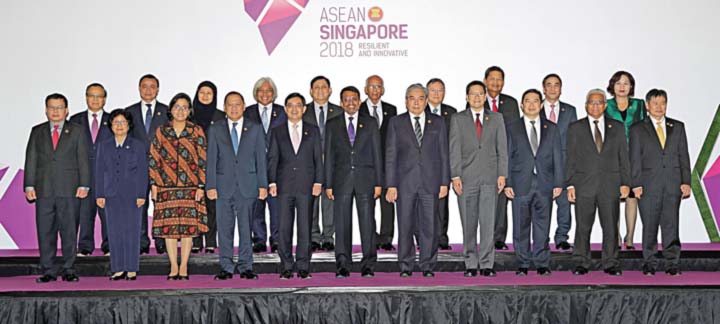
While America and Europe have to deal with China’s strength, economies of Asean focus on their own dream of creating a single market that promotes the development of members.
In 2007 the Asean Economic Community (AEC) Blueprint was adopted to create a single market and production line from 2018 to 2015.
The AEC, with its huge market of US$2.6 trillion and over 622 million people, has since then attracted global economic giants such as China, the European Union, Canada, Japan and South Korea.
Now on its second phase of economic integration under AEC 2025, the Asean market continues to gain traction.
Dr. Alladin Rillo, Deputy Secretary General of Asean Economic Community, said the populations of member-economies have yet to fully benefit from the gains of economic integration because AEC agreements have not been implemented on the ground.
Asean members need to pass national laws to implement AEC agreements on single market rules.
The late Asean Secretary General Dr. Surin Pitsuwan had reminded members to be “complementing and not competing to achieve the AEC success.”
At the same time, external challenges such as the US-China trade war are expected to have an adverse impact on the region’s financial market since members have strong roles in the global value chain.
Rillo said the trade war between the US and China “creates uncertainties” and can be problematic once it escalates to the macroeconomic market of Asean.
“Economic ministers of Asean recognize the implications [of US-China] trade war due to our strong participation in the global value chain or regional production network, particularly China…that really affects us,” said Rillo at the 7th Editor’s Roundtable of the Economic Research Institute for Asean and East Asia (ERIA) held in Singapore over the weekend.
Asean groups the Philippines, Singapore, Thailand, Vietnam, Cambodia, Lao PDR, Myanmar, Brunei, Malaysia and Indonesia.
Professor Hidetoshi Nishimura, president of ERIA, said the regional bloc has gained importance both economically and politically.
“But the region must adhere to the emerging challenges, such as health, aging society, sustainable environment and agriculture, as well as disaster risk reduction and building smart cities,” said Nishimura during the ERIA forum.
Ambassador Bilahari Kausikan, chairman of the Middle East Institute of National University of Singapore (NUS), said Asean needs agility, unity and resolve to cope with the US-China war.
He agrees with some analysts that the trade war between the two giants will open medium-term opportunities for Asean when foreign investors shift production out of China into Southeast Asia.
“This is possible but short-sighted,” Kausikan said. “Shifting production out of China is easier said than done and no one, trade war notwithstanding, will forgo the Chinese market, although new and upgraded investments will probably be postponed.”
Kausikan, who was keynote speaker at the roundtable, agrees that the trade war between the US and China will change the supply chains, once accusations that China planted spy microchips in motherboards used by the CIA and Pentagon are proven.
“Shifts in supply chains could derail or seriously complicate efforts by Asean members to move up the value chain. Asean members must in any case resist the temptation to act as a backdoor into the US for Chinese companies,” said Kausikan, who served as ambassador at large of Singapore’s Foreign Ministry.
He said Asean, now entering its second phase in creating a single market and common production platform, needs to take advantage of opportunities in the US-China trade war by dealing with domestic politics.
Asean members remain divided in adopting the Code of Conduct in the South China Sea amid Beijing’s expansive military buildups in the South China Sea and uproar from claimants—the Philippines, Vietnam and Malaysia.
For his part, former Asean secretary general Ong Keng Yong said members need to promote Asean centrality amid global tensions.
Ong is now the executive deputy chairman of the S. Rajaratnam School of International Studies at the Nanyang Technological University in Singapore.
“Asean needs [to maintain] devotion to rule of law, Treaty of Amity and Cooperation that peacefully settles disputes on sovereignty and territorial integrity, as well as multilateralism,” said Ong, who was also speaker at the forum.
Image credits: AP/Wong Maye-E




































